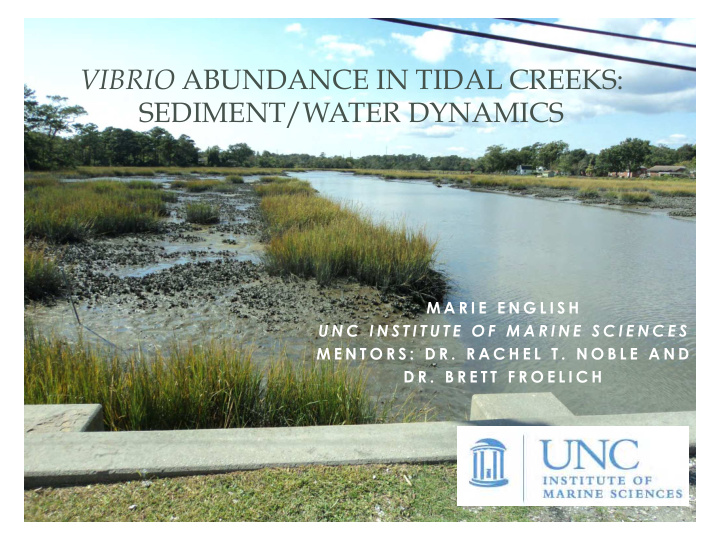



VIBRIO ABUNDANCE IN TIDAL CREEKS: SEDIMENT/WATER DYNAMICS M A R I E E N G L I S H U N C I N S T I T U T E O F M A R I N E S C I E N C E S M E N T O R S : D R . R A C H E L T . N O B L E A N D D R . B R E T T F R O E L I C H
THE GENUS VIBRIO • Native to estuaries (Nearly 35% of coastal bacterial pop.) • Facultative anaerobes • Pathogenic spp. • Vibrio cholerae, Vibrio vulnificus, Vibrio parahaemolyticus • V. vulnificus is most important seafood-borne pathogen in the USA • Can cause wound infections, septicemia, gastroenteritis • Recent research shows climate change is leading to an increased # of vibrio cases (Oliver, DUML seminar) • Ecology • Influenced mainly by salinity and temperature • Halophilic • Predictive models for vibrio sp. concentrations based on salinity and temp are 70-75% accurate (Hsieh et al., 2007)
SALINITY/TEMP RANGE FOR PATHOGENIC VIBRIO SP. • Optimal salinity range • 5-25 ppt • Very low and very high salinities appear to be detrimental to growth and persistence (Noble, 2008) • Optimal water temp. range • 20-30 ⁰ C is where the highest concentrations are seen • Below 20 ¡⁰ C = low density of vibrio • Below 10 ¡⁰ C = no vibrio in water column Parameter Range Mean and S.D. Salinity (ppt) 15.00 - 32.00 26.05 ± 5.875 Temperature ( ⁰ C) 15.41 - 30.32 22.67 ± 4.316
“The Biology of Vibrios”
STUDY SITES
INDIVIDUAL SITES Site 1 Site 2 Site 4 Site 3 9/27
PART OF THE LOCAL COMMUNITY Locals fish for shrimp, flounder, and mullet
CALICO CREEK SAMPLING
CALICO CREEK SAMPLING
PROCESSING
TOTAL VIBRIO ENUMERATION 10/5 CFU= colony forming units
CHROM AGAR 10/5 Purple colonies= V. parahaemolyticus Blue colonies= V. vulnificus 9/27
WHAT CAUSES THE DECLINE IN VIBRIO ABUNDANCE IN THE WATER COLUMN?
WHAT CAUSES THE DECLINE IN VIBRIO ABUNDANCE IN THE WATER COLUMN?
BACTERIA IN THE WATER COLUMN DECREASE WHEN CONDITIONS ARE STRESSFUL Low temperatures = Stressful for bacteria
POST-HURRICANE SANDY = COOLER WATER TEMPS 1 2 3 4 Sed. (1:10) Water (1:10) Water (1:1) 11/1
BACTERIA IN THE WATER COLUMN DECREASE WHEN CONDITIONS ARE STRESSFUL High salinities = stressful for bacteria
VIBRIO SP. ABUNDANCE IS HIGHER IN SEDIMENTS
SEDIMENT > WATER 2S 1S 2W 1W 4S 3S 4W 3W 9/27
ARE SEDIMENT ABUNDANCES AFFECTED BY STRESSFUL CONDITIONS?
SEDIMENT PROTECTION
SEDIMENT PROTECTION
ARE SEDIMENT ABUNDANCES AFFECTED BY STRESSFUL CONDITIONS?
IS THIS UNIQUE TO VIBRIO, AN AUTOCHTHONOUS BACTERIA?
IS THIS UNIQUE TO VIBRIO, AN AUTOCHTHONOUS BACTERIA?
FUTURE STUDIES • Continue study in colder months using qPCR to compare with cultured methods for signs of overwintering (VBNC cells) • Must use molecular methods below 15 ¡⁰ C because the cells enter a state where they are no longer culturable • Organic matter content of sediments and correlation with pathogenic Vibrio • Grain size analysis of sediments and correlation with pathogenic Vibrio
CONCLUSIONS 1. In harsh conditions, Vibrio decrease in the water column. 2. Bacteria are found in higher concentrations in the sediments 3. Vibrio in the sediments are somewhat protected from salinity and temperature changes in water column 4. The sediments provide protection for endogenous bacteria, but the same pattern was not seen for exogenous (the control).
ACKNOWLEDGEMENTS Rachel Noble Brett Froelich Sarah Rhodes Sydney Brothers Denene Blackwood Monica Greene Raul Gonzalez Mark Vergougstraete Rodney Guajardo Sara Posey
BIBLIOGRAPHY • DUML Seminar with Dr. Jim Oliver: " Vibrio vulnificus: Death on the Half-Shell ” Wednesday, August 29, 201212:30pm, LSRC A328 & Marine Lab: Repass Center • Thompson, Fabiano Lopes, Brian Austin, and J. G. Swings. "12: Aquatic Environment." The Biology of Vibrios . Washington, D.C.: ASM, 2006. 176. Print. • Hsieh, Jennifer L., J. Stephen Fries, and Rachel T. Noble. "Dynamics and Predictive Modelling of Vibrio Spp. in the Neuse River Estuary, North Carolina, USA." Environmental Microbiology 0.0 (2007): 070907020408001-??? Print.
Recommend
More recommend